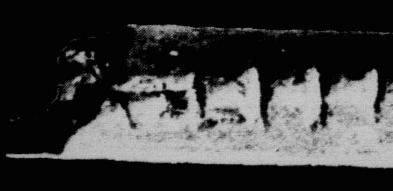Candidate #1. The Lebombo Bone

A small piece of the fibula of a baboon, marked with 29 clearly defined notches, may rank as the oldest mathematical artefact known. Discovered in the early seventies during an excavation of the Border Cave in the Lebombo Mountains between South Africa and Swaziland, the bone has been dated to approximately 35,000 B.C. In a description of the bone, Peter Beaumont, an archaeologist who has done extensive work on Border Cave, has noted that the 7.7 cm long bone resembles calendar sticks still in use today by Bushmen clans in Namibia.
— from The oldest mathematical artefact by Bogoshi, Naidoo, and Webb

The above information has been repeated more or less verbatim across various sources which want to mark the beginning of math history.
But how accurate is it?
29 clearly defined notches
Count on the above picture: you will likely get a count of 29 or 30. The extra possible mark is on the left-hand side of the bone; it looks like it is possible 3 tally marks in quick succession. However, the middle “tally mark” is just a blemish on the image; taking a different image of the same stick and inverting the colors makes the picture clearer:

So: there are 29 notches, although the leftmost one is truncated enough one gets the impression the bone is broken. So does the count stop at 29 or does it continue?
There is some mathematical evidence that perhaps the leftmost notch is indeed the last: it is placed at roughly a 25 degree angle; the second steepest (tally mark #8) is only a 12 degree angle. I interpret this as the ancient tally-cutter “dragging” the diagonal mark, making it more likely to be a starting or ending mark.
29 also appears elsewhere in ancient counting, including a supposed lunar calendar in the Lascaux caves (painted 15,000 BC):

the bone has been dated to approximately 35,000 B.C
The latest data has put some the bones of the Border Cave at an earlier date than originally calculated in the 70s; however, the Lebombo bone has not received similar treatment.
resembles calendar sticks still in use today by Bushmen clans in Namibia.
Search for “calendar stick” and “Namibia” and the references are not to actual modern calendar sticks, but to the Lebombo bone. I was not able to find a single reference to modern calendar sticks — or an calendar sticks at all — in Namibia other than through mentions of this bone. Given how much Peter Beaumont knows about African archaeology, I’m going to presume this is a gap in the research literature, but it’s definitely a bizarre one.
The oldest mathematical artefact
This claim for “oldest” was made in 1987, but there are now other contenders for the title, including some discoveries made only announced this year; they will be the subject of future posts.
Filed under: History, Mathematics |


[…] artifact?” There are several candidates, and according to The Number Warrior, candidate #1 is The Lebombo Bone, found in the Lebombo Mountains of South Africa and Swaziland, that dates back to 35,000 […]
[…] (part 1 here) […]
[…] […]
[…] clans in Namibia.” – from The oldest mathematical artefact by Bogoshi, Naidoo, and Webb, in What’s the Oldest Mathematical Artifact? Cf. com outro objecto muito semelhante, conhecido por Ishango […]
Why did the Wikipedia say that there is no reliable source to prove this?
Everything is based off one original article; unlike the Ishango bone the physical artifact hasn’t had much activity on it. So someone doubted the artifact existed.
However, the original article is written by a well-known and still-active scholar (albeit not a specialist in mathematics) and there’s not much reason to doubt.
You said “there are now other contenders for the title, including some discoveries made only announced this year; they will be the subject of future posts” … There are no such posts. Can you give us some clues?
Well, there’s this one:
Parts III and IV are in my queue to write.
Thanks for the reply, Jason.
Your queue seems even longer than mine! I saw Part II, but the thought of even older items is of more interest. I’m finishing a book on Business Intelligence at present and have the Lebombo Bone as the oldest artifact. Can you help? Many thanks, Barry.